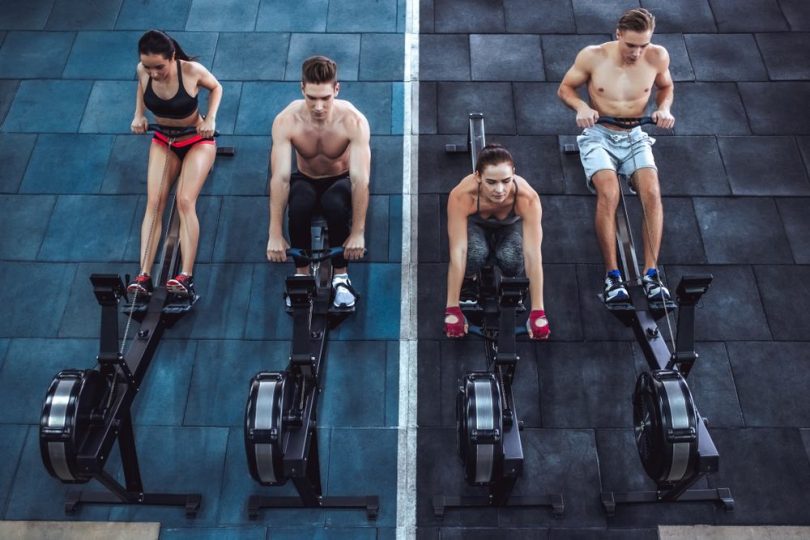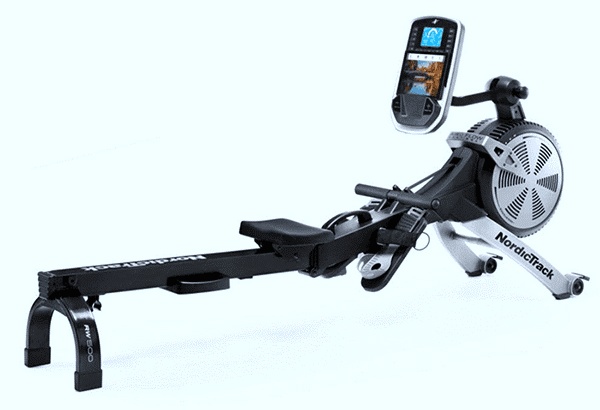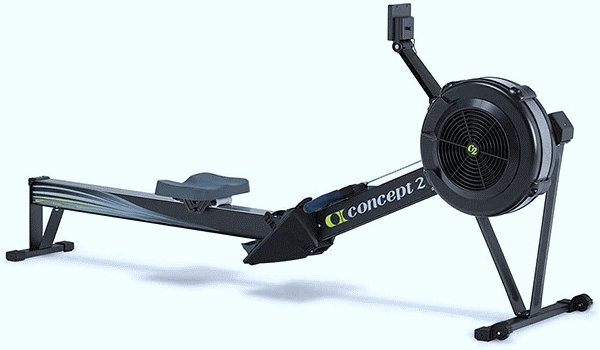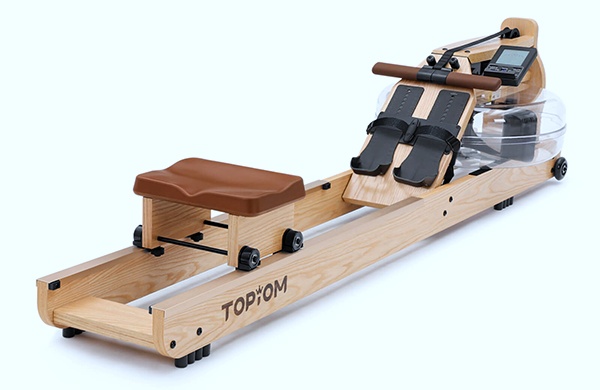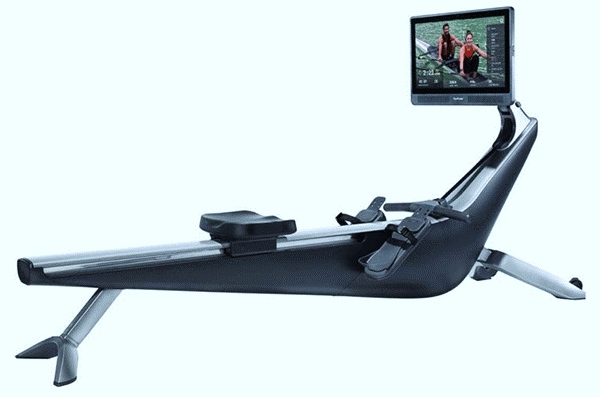Rowing machines are an excellent choice for endurance training. They provide a full-body exercise, requiring the same level of effort from your upper and lower body parts to complete a full stroke.
Rowing engages a wide range of muscles and helps burn 600 -1,000 calories per hour, allowing you to get the most out of a single machine.
Here we’ll get familiar with the different types of rowing machines out there, their design and purposes, and how they differ from each other.
Different Types of Rowers
1. Hydraulic piston Rowing Machines
Among its other variations, only the Hydraulic-piston resistance allows an independent workout for each arm. That means you can work out each arm independently. This is a great way to fix muscle imbalances.
These types of rowers use hydraulic pistons for resistance and most have two pistons with one piston being attached to each arm of the handlebar. You’ll be able to adjust the resistance by turning the knob located on the piston.
The main benefit is they are quiet and allow you to use them while watching tv or listening to music.
If your budget is tight and you do not want to spend a lot of money on a rowing machine, this is for you
Features
Size: Average hydraulic rowers are only 4 to 5 feet long and 2 to 3 feet wide
Adjustability: You can control the resistance-level through a level setting, usually located on the pistons
Rowing Motion: The rowing motion on a hydraulic piston rower isn’t as smooth as it’s other counterparts. However, the motion is capable enough to provide a full-body workout
Ideal for: People with Beginner and intermediate-level skills are the ideal candidate to use the hydraulic piston rower. This machine can support elderly people.
However, we don’t recommend this machine to athletes as the machine isn’t designed for them
Misc.: Hydraulic piston rowers have a smaller seat rail. That’s why they aren’t a good option for tall users
Noise-level: Quiet
Storage: The small size makes it easy to store
Price range: $100 – $600
Advantages
- Great for upper body workout
- They’re virtually silent
- Compact and lightweight in design
- Known as the most practical type of rowers
- Can be stored easily
Disadvantages
- The build quality is not so premium like some other types
- The pistons can get hot while working out for long periods of time
- You cannot move your body in such a way that you are in a natural position for rowing
- Some may find the motion of the dual handles uncomfortable
2. Air/magnetic Rowing Machines
Also known as mag-air rowers, these hybrid rowing machines offer a combination of magnetic and air resistance and is an affordable alternative to the air machines.
These rowers can adjust the magnetic tension by moving the magnet closer or farther away from a metal flywheel. You will also be able to row faster and have more resistance from the additional “air” resistance.
Combination rowing machines usually have the strongest resistance because there two resistance mechanisms are working simultaneously .
The harder you row, the heavier air resistance you’ll feel.
Features
Size: Large (longer seat rail)
Storage: Need to be folded for storage (most models)
Adjustability: Adjustable and low-end magnetic resistance meets with variable and high-end air resistance to give you more adjustability
Noise-level: In between the louder air-only rower and the quieter magnetic-only rower
Rowing Motion: Similar to outdoor rowing, with heavier resistance
Ideal for: Beginner, intermediate and advanced; people from every experience level can row
Misc.: Some models can control resistance through the handlebar
Price: Around $300 – $1,500, depending on the features
Advantages
- Provides a good cardio workout
- The resistance can be adjusted as per your need
- Better strength component
- Provides full range of movements
Disadvantages
- The resistance is less dynamic, and the rowing experience is less smooth than it’s counterparts
- Doesn’t closely mimic the resistance felt from “on the water” rowing – a downside for many
3. Air Rowing Machines
Committed fitness enthusiasts usually use a air rower, which is one of the most popular forms. Since it’s invention in the 1980s, the air rower has been considered as the best type of rowing machine for decades.
A rotating fan flywheel provides resistance to air-resistance rowing machines. The flywheel spins and generates wind when the rower pushes the handle.
Usually, the faster your rowing speed is, the faster its flywheel will spin to create a higher resistance.
Features
Size: Usually larger than other resistance-types
Storage: Most units can be folded or taken apart for storage
Rowing Motion: Similar to outdoor rowing, smooth and strong
Noise-level: Loudest of all resistance-types due to the constant spinning of the flywheel
Ideal for: All fitness levels (beginner, intermediate, advanced)
Misc.: The longer rails make it suitable for taller rowers with long legs
Adjustability: Resistance is ‘variable’ based on the rowing intensity
Price : ~$300 – $1,300
Advantages
- Smooth action
- ‘Automatic’ resistance is adjusted to your stroke rate
- Long-lasting mechanism
- Wide range of resistance available replicating rowing on water
- The rower simulates rowing outdoors well and is not as costly as the water-resistance rower
Disadvantages
- The spinning flywheel creates an irritating sound every time you pull the handle
4. Water Rowing Machines
Water rowing machines provide a more realistic feel than their air, magnetic or hydraulic counterparts. There are paddles suspended in a tank of water to create resistance.
The paddles rotate in the water when you pull back on the handle. The weight of the rushing water acts as a drag on the paddles, causing resistance as a result.
The harder the handle is pulled, the faster the paddles spin.
Features
Size: Large and fairly heavy
Storage: Storing your rower standing upright is the best position. That way, the footprint will be similar to your dining room chair
Adjustability: To adjust your rower, you’ll need to control the amount of water in the water tank. The more water you have, the greater the resistance will be. Additionally, the resistance also depends on the rowing intensity
Noise-level: They are quieter than the air-based rowers. However, you’ll still hear the sound of your paddles splashing the water.
Rowing Motion: Similar to outdoor rowing
Ideal for: No matter what your fitness level is (beginner, intermediate, or advanced), you can use a water-based rower
Misc.: Water based rower will give you the closest experience to rowing on an actuall water body
Price : $700 – $2,000
Advantages
- Smooth, consistent resistance throughout the strokes
- No ‘flat spot’ where the resistance drops during the stroke cycle
- Quiet operation
Disadvantages
- Larger than other types of rowing machines
- Expensive
5. Magnetic Rowing Machines
Magnetic rowers are quiet with a smooth rowing action that makes them the first choice for home use.
For resistance, magnetic rowing machines use a magnetic brake mechanism. A magnet can be positioned closer or farther away from a metal flywheel as it spins to create resistance.
The resistance levels can be modified with either mechanical sliders or digital controls on the console.
Features:
Size: Usually big because of a longer seat rail
Storage: Most units can be taken apart/folded in half for safekeeping
Adjustability: Usually has a setting to control the resistance-level. Can be adjusted by turning a node or pressing a button on higher priced models
Noise-level: Quiet
Rowing Motion: Similar to air-resistance. However, the motion isn’t as smooth or strong
Ideal for: People from every experience level can try air rowers. If you want a
a great workout minus the noise of air or water rowers, it won’t matter if you are beginner, intermediate, or advanced
Misc.: The magnetic rower is a mid-range machine. It is similar to an air rower, buit isn’t as loud.
Price : $200 – $1,400
Advantages
- A wide range of workout options to choose from
- You can choose the muscle group you want to work on
- Adjust the resistance according to your needs and skill level
- Doesn’t generate much noise
Disadvantages
- Weak resistance on magnetic rowers
- Don’t simulate rowing on water
What type of rowing machine is best for you?
The answer to that question lies in questions like how skilled you are, how much noise you can tolerate, what type of workout you are looking for, and how much space you have.
If you want the authentic and smooth rowing experience, go for the water based machines. However, they’re quite expensive. Some cheaper alternatives include air, magnetic and hybrid options.
Air based rowers are designed for taller people, but they are noisy. In case you want a cheaper option or want to work exclusively on your upper body, a hydraulic rowing will serve you the best.
If you want to work on your body muscle by muscle, a magnetic rower will help you do that. However, they take up a lot of space.
As you can see, each type of rowers has their own pros and cons. You’ll need to choose the perfect machine for you as per your requirements.
FAQs
Q. Does a rowing machine replicate real rowing?
The muscles worked are similar whether it’s outdoor rowing in a boat or indoors on a rowing machine. Both forms are guaranteed to get your heart rate going and provide a killer total-body workout!

